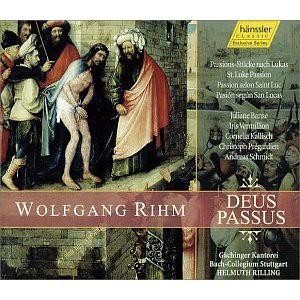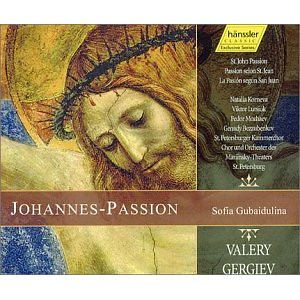La Pasión según San Marcos
by , 07-27-2010 at 12:23 AM (3341 Views)
In 2000... the 250th anniversary of J.S. Bach's death, the International Bach Academy of Stuttgart commissioned new settings of the 4 passion narratives of the Gospels: Matthew, Mark, Luke, and John. These commissions went to four very different contemporary composers: Wolfgang Rihm, Sofia Gubaidulina, Tan Dun, and Osvaldo Golijov:
I have owned Tan Dun's Water Passion After St. Matthew for some 4 or so years now. It is a strange... yet somehow compelling work. The other three have been on my wish list for a good length of time now. Today my copy of Golijov's La Pasión según San Marcos arrived and I have been giving it a first listen. Where Tan Dun's effort was decidedly challenging... at times difficult... clearly within the Modernist tradition, Golijov's work is decidedly populist... employing the rhythms, instrumentation, joyful choruses, language (it is largely in Spanish... with some Latin and Aramaic passages) of Latin American Music.
The reviewer of The New Yorker exclaimed that Golijov's La Pasión según San Marcos "drops like a bomb on the belief that classical music is exclusively European art. It has a revolutionary air," while the Boston Globe critic declared the work to be "the first indisputably great composition of the 21st century." I agree on all accounts. It is along with Peter Lieberson's Neruda Songs and David Lang's Little Match Girl Passion one of the strongest and most moving works of classical music written since the turn of the millennium.
The piece is truly revolutionary... in the same manner in which Gershwin's Porgy and Bess was revolutionary in that like Gershwin's constuction of a serious opera based upon the jazz and other native American popular and classical music traditions, Golijov has the audacity to construct a work of "serious" music... a passion play in homage to that greatest of European masters: J.S. Bach... from the traditions of folk, pop, and classical music of Latin America.
Osvaldo Golijov was born and raised in Argentina of Jewish Romanian and Russian heritage. In the 1980s he moved to Israel where he absorbed the musical traditions of the Middle-East: ancient Hebrew, Arabic, and Christian. Over his career, his music has merged elements of this tradition with those of Latin-American and Spanish music, klezmer, Western classical, and pop. Golijov stages the entire drama of the Passion of Christ within a Latin-American setting that displays his affinity with the music of this aspect of his heritage far more than any other work that I have heard by the composer.
Golijov argues that Christ was a man of the people... a man of the streets... and should be presented in decidedly populist manner. Christ himself is often represented by the voice of the entire choir: as everyman. The composer employs a large choir that at times divides into two or even three choirs which echo or even argue with each other. The composer states that he thought of the distinct choirs as being based upon South American Easter processionals rooted in the Latin American synthesis of Catholicism and the Yoruba religion brought by African slaves. He intends something connoting the rituals and joyful processions coming from various villages as opposed to the Protestant tradition of somber meditation.
The initial effect of La Pasión según San Marcos is somewhat disconcerting... as if the take on the most sacred of narratives was almost blasphemous. The composer, after all, has the audacity to set this most sacred of narratives within a musical frame that at times suggests a rowdy South American night club with blaring horns and singers with sensuous smokey voices mouthing songs of seduction. But the music is also very effective.
There are sudden shifts in mood... going from the most uproarious and passionate, to passages of simplicity and quiet. In the scene of Gethsemane, the music suggests a delicate English choir with voices sailing high above. In the face of this, a mezzo sings the most haunting tune... suggestive of the Spanish lament or "deep song".
The most moving moment comes with the aria, Lúa Descolorida (Colorless Moon... the Aria of Peter's Tears). This aria sets a poem by Garcia-Lorca's beloved Rosalía de Castro written in Gallego (the language of the Galicia region in Spain) and defines despair in a way that is simultaneously tender and tragic. The soloist sings her haunting lament against the muted sounds of a string quartet. The aria was originally written for and performed by the singer Dawn Upshaw. Golijov states "the strongest inspiration for Lúa Descolorida was Dawn Upshaw's rainbow of a voice... I wanted to give her music so quietly radiant that it would bring an echo of the single tear that Schubert brings without warning..." It achieves this quite well... and in the context of the Passion... following Peter's 3rd denial of Christ... it powerfully conveys his emotions... his regret, pain, torment, and mourning. In a sense, it stands as the emotional climax of the entire work.
Where Lúa Descolorida is preceded by a moment of silence that makes it all the more powerful, it is followed by vicious voices... almost hissing and spitting... as they mock Christ. The Passion rapidly unfolds at this point. The journey to Golgotha and the crucifixion are accompanied by a raucous... at once mocking... yet joyful chorus that at once suggest Christ's tormentors... but also the joy of the believers who celebrate the Crucifixion as the penultimate event in the life of Christ... and ultimately humanity.
In the final moments the Crucifixion is portrayed... as it might be in a Latin-American passion play. The choir as the crowd shouts in derision: "Come down from the cross if you be the King of the Jews." And then: muerte... and Christ calls out, "Elohi, Elohi, Lama Shabachtani"... "My God, my God, why have you foresaken me?" In the final movement, Kaddish, a haunting Prayer for the Dead sung in Christ's own language of Aramaic as the women mourners repeat Christ's final words.
This particular recording comes complete with a DVD recording of a 2008 live performance of the work in Holland. I cannot recommend it highly enough.
http://www.youtube.com/watch?v=mvTiWPV2da0
http://www.youtube.com/watch?v=c5FgO...eature=related
http://www.youtube.com/watch?v=qceyTSpNxik








